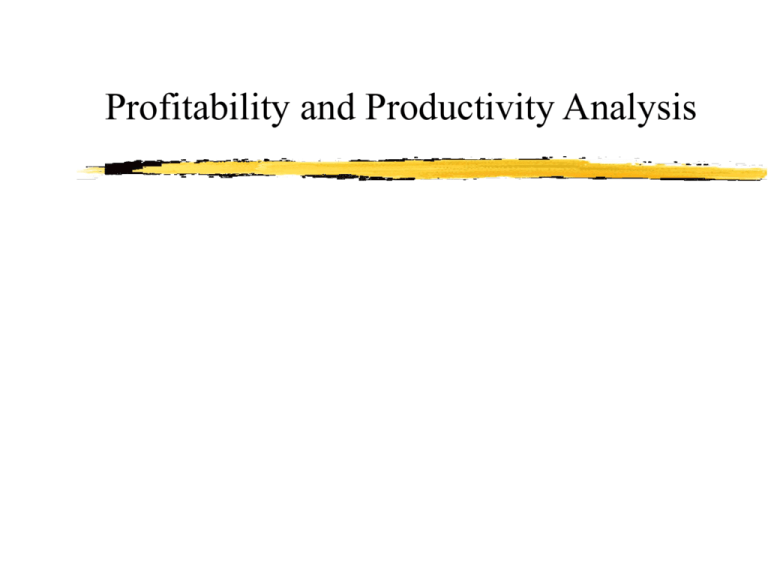Profitability and Productivity Analysis
advertisement

Profitability and Productivity Analysis Profitability and Productivity Analysis Productivity Analysis is the assessment of the sales or market share consequences of a marketing strategy Profitability Analysis is the assessment of the impact of various marketing strategies on the profit contribution that can be expected from a product or product line Factors to Consider in Making Marketing Expenditures Expected Productivity in Terms of Sales Impact on Profitability Structure Decision Product Objective Industry Sales Forecast LINKSTER INC: Profit and Loss Statement Sales ................................................................................................... $4640 Less cost of goods sold ................................. ...................... 2300 Gross Profit Margin .............................................................. $2340 Operating Expenses: Advertising ......................................................... $600 Sales Salaries ...................................................... 500 Sales Commissions ............................................. 220 Designer’s Salaries ............................................. 400 Other (general and admin. costs )........................ 600 Total operating expense .......................................... 2320 Net operating profit (loss) before taxes .............................................. $20 Measuring Product Profitability Need to Distinguish Between: Variable costs Fixed Costs – direct or tracable – indirect or nontracable LINKSTER INC: Contribution Margin Statement Sales ............................................................................................................ $4640 Less variable cost of goods sold (Labor, materials, etc.) ............. 1620 Gross Profit Margin ...................................................................... $3020 Less other variable selling costs (sales commissions) ................. 220 Variable contribution margin ...................................................................... $2800 Fixed costs: Advertising ................................................................. $600 Sales salaries .............................................................. 500 Fixed production costs ............................................... 680 Designer’s salaries ..................................................... 400 General and administrative overhead ......................... 600 Total operating expense ................................................. 2780 Net operating profit before taxes ................................................................. $ 20 LINKSTER INC: Contribution by Product Line Sales Variable cost of goods sold Gross Profit Margin Other variable costs Variable contribution margin Company Total $4640 1620 $3020 220 $2800 Umbrellas $840 400 $440 40 $400 Sweaters $2400 800 $1600 120 $1480 Jackets $1200 380 $ 820 60 $ 760 Cap $200 40 $160 0 $160 Direct, traceable fixed costs: Sales salaries Designer’s salaries Fixed production costs Advertising of product lines Total Total Contribution $ 500 400 680 300 $1880 $ 920 $ 20 0 100 40 $160 $240 $ 360 300 340 200 $1200 $ 280 $ 120 100 230 60 $ 510 $ 250 $ 0 0 10 0 $ 10 $150 Indirect, nontraceable fixed costs: Institutional advertising General and admin. overhead Total Net Operating Profit $ 300 900 $1200 $ 20 LINKSTER INC: Percentage Variable Contribution Margins Umbrellas Number of customers 28,000 Average price paid $30 Variable Cost per Unit $15.71 Variable Contribution Margin per Unit (Average price - Variable cost) $14.29 PVCM = (Price - VC) Price 47.6% Sweaters 40,000 $60 $23.00 $37.00 61.6% Jackets Caps 20,000 50,000 $60 $4 $22.00 $0.80 $38.00 63.3% $3.20 80% Cost-Volume-Profit Relationships Economies of Scale Experience Curve Effect Economies of Scale for Sweaters Annual sales volume 40,000 units 80,000 units Unit variable cost Multiplied by volume Total variable cost Plus: Total direct fixed cost Total Direct Cost Divided by Volume $ 23 40,000 $ 920,000 $1,200,000 $2,120,000 40,000 $ Average Unit Cost $ $ 53 23 80,000 $1,840,000 $1,200.000 $3,014,000 80,000 38 The Direct Approach to Marketing Budgets 1. Develop an industry sales forecast 2. Estimate the market share that will result from a given price and marketing expenditure level 3. Calculate expected company sales (Market share X Industry Sales Forecast) 4. Calculate variable contribution (Company Sales X Percentage Contribution Margin) 5. Calculate total net contribution (Variable Contribution Margin less Direct Fixed Costs) 6. Determine whether sales, market share and total contribution levels are acceptable LINKSTER INC: Projected Profitability for Jackets Current Year Projected Sales X PVCM Variable Contribution Margin $1200 .6333 $ 760 $1500 .6333 $ 950 Direct, traceable fixed costs: Sales salaries $120 $120 Advertising 60 160 Design 100 100 Fixed production 230 230 Total, direct traceable $ 510 $ 610 Total Contribution $ 250 $ 340 Productivity Analysis Analysis of Historical Relationships Competitive Parity Analysis Market Experiments Judgment-Based Productivity Estimates Cross-Elasticity Effects Judgment-Based Productivity Estimates What level of expenditure is needed to maintain current market share? What minimum level of market share will result if expenditures are reduced to Zero? What level of market share will result if expenditures are increased by 50%? What is the maximum market share that could be obtained if expenditures were unlimited? Judgment-Based Productivity Estimates Market Share (Max) 15 (Plus fifty) 13 (Current) 10 (Min) 5 1.5 2.0 3.0 Advertising (Million $) Cross-Elasticity Effects Substitution Effects Complementary Effects Related Use Enhanced Value Convenience LINKSTER INC: Projected Budget with CrossElasticity Effects Projected Total Unit Sales Dollar Sales Total Contribution Projected Change 25,000 $1,500,000 $340,000 Plus 5000 Plus $300,000 Plus $90,000 Plus complementary effects: Cap sales (5000 X 10% X $4) X PVCM $2,000 80% Plus $1,600 Umbrella sales (5000 X 30% X $30) X PVCM $45,000 47.60% Plus $21,420 Minus substution effects: Sweater sales (5000 X 10% X $60) X PVCM Net Change In Total Contribution Minus $18,460 Plus $94,540








